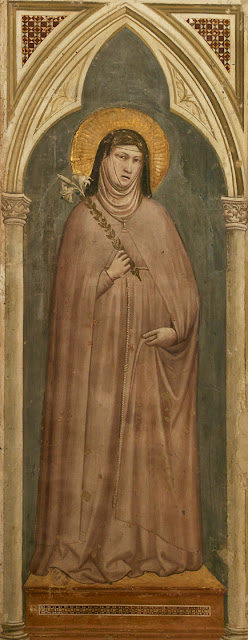Saint Clare by Giotto 1325
Saint Clare (1325) Fresco inside the Bardi Chapel, Santa Croce, Florence
On the window wall of the chapel Franciscan saints are portrayed, standing under painted arcades. One picture has been destroyed; St. Clare, St. Elizabeth of Thuringia and St. Louis of Toulouse can still be seen. Saint Clare is represented in the traditional way on a very high artistic level.
Giotto also received the commission for the second surviving chapel in the Franciscan church of Santa Croce in Florence from a banker. The donor Ridolfo de' Bardi and his brother jointly inherited their father's banking house and commercial interests. This involved maintaining a good relationship with the powers who determined the politics of the day - with the pope, with the Neapolitan ruling house of Anjou, and with the Guelph party. He was able to go on cultivating this highly effective mixture of faith, politics and money for the next three decades until his house went bankrupt in the 1340s.
The Bardi family chapel is situated to the right of the choir, which means that it is the first chapel of the southern transept, and dedicated to St Francis. As was the case with the neighboring Peruzzi Chapel, these frescoes were also painted over in the 18th century, rediscovered in the 19th century, and reworked. During their restoration in the middle of the twentieth century, all reworked areas were removed and the ruined parts sealed with plaster. For this reason, some of the frescoes have empty spaces, although the actual painting is considerably better preserved here than in the Peruzzi Chapel, since Giotto went back to working with fresh plaster here.
As in the Peruzzi chapel, three frescoes framed by ornamental bands decorate each wall. But unlike in the former, these are dedicated to just the one saint, St. Francis. The Renunciation of Worldly Goods and the Confirmation of the Rule are situated in the lunettes. In the middle register the Apparition at Arles and the Trial by Fire before the Sultan are depicted. The Death of St. Francis and Inspection of the Stigmata and the Apparition at Aries can be seen at eye level. Above the entrance to the chapel the Stigmatisation is portrayed, as it were, as a summation of the life of the saint. The seraphim from whom Francis receives the stigmata here appears - unlike at Assisi or in the panel in the Musée du Louvre - as the crucified Christ.
While the St Francis in the paintings in the Upper Church at Assisi wears a beard, Giotto depicts him without one here, as in the vault frescoes in the Lower Church. This manifestation of the saint, favoured by the order since 1316, must have been particularly agreeable to a banker, since it no longer expressed the original significance of personal poverty.
Unlike the Peruzzi Chapel, the construction of the architecture portrayed in the frescoes is here based on a viewpoint within the chapel. The perspective of the architectural structures in the paintings changes with great logical consistency - the higher the register, the greater the foreshortening from below. This only increases the impression of fluidity between real and painted space.
This image is a public domain image, which means either that copyright has expired in the image or the copyright holder has waived their copyright. Franciscan Gallery charges for the access to high resolution copy of the image. Manually restoration was necessary in order to improve quality, without covering the original image.






Comments
Post a Comment